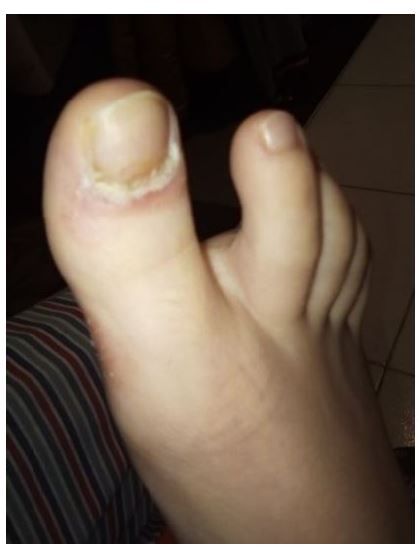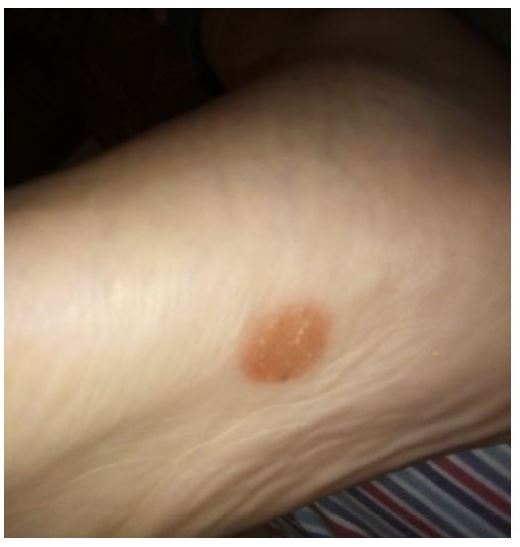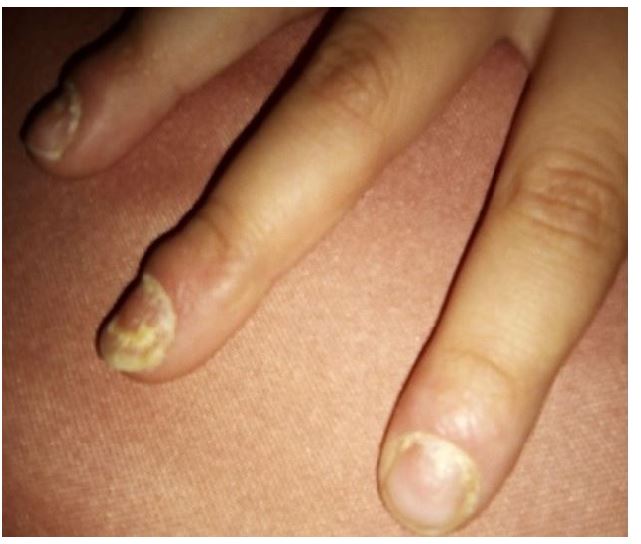A ten-year-old boyobserved during a routine pediatric visit presented withnail changes onthe hands and toes and a concomitantskinlesion on the sole of the foot. Fever, pain, or direct contact with similar lesions were denied. Family history revealed that the mother was followed in rheumatology for suspected autoimmune disease and thegrandmother had rheumatoid arthritis.
On physical examination, the boy presented with yellow and thickened proximal and lateral nail folds onthe right hallux andfourth toe of the left foot (Figure 1) and an erythematous squamous plaque on the sole of the right foot (Figure 2). Ten months later, the boy presented with multiple yellowish, scaly, and thickened finger and toe nails (Figure 3).
Discussion
Psoriasis is a systemic inflammatory disease that affects the skin, mucous membranes, phanera (nails and scalp), and joints, with variable presentationand severity. The average age of onsetis 7-10 years, meaning that one third of adults with psoriasis have their first symptoms before the age of 20.1,2A positive first-degree family history is reported in 17% of children and adolescents with psoriasis, possibly predicting more severe disease.1,3
Similar to adults, the most commontype of psoriasis in childrenis plaque psoriasis, which presents as erythematous plaques with a silvery-white scale typicallyaffecting thelimbs, scalp,postauricular region, elbows, knees, and umbilicus. Children may have thinner plaques with irregular borders and morefacial and anogenital involvement than adults, with facial psoriasis being the sole manifestation in 4-5% of cases and anogenital psoriasis being the most common manifestation under two years of age.1,4Anogenital involvement, possibly related to the Koebner phenomenon (appearance of skin lesions on previously unaffected skin secondary to trauma), presents as alarge area of confluent erythema or salmon-colored patches or plaques.1,2) Guttate psoriasis and psoriatic arthritis are also more common in children. The former manifests as drop-like, erythematous, scaly, small papules on the trunk and extremities, often preceded by group A beta-hemolytic streptococcus infection, and the latter is characterized by joint pain, most commonly affecting the fingers and toes.4
Childhood psoriasis has a widespectrum of physical manifestations,with nail involvement occurring in 12-32% of cases.Nail psoriasis maymanifest as plate dystrophy, leukonychia, hyperkeratosis, and nail fold involvement, as described in the presentpatient. Other nail lesions described in the literature may include pitting, splinter hemorrhages, oil droplets,andsalmon spots, among others.1,5
Because most patients with nail psoriasis have concomitant cutaneous psoriasis or psoriatic arthritis, the patient history should include an assessment of personal history for signs or symptoms of these conditions. A strong family history of psoriasis may also raise suspicion of nail psoriasis in a patient with no other manifestations. A complete skin examination, including nails, scalp, and anogenital skin,should also be performedto evaluate forother psoriasis-related changes.1
The diagnosisof nail psoriasis is clinical. Differential diagnosis withonychomycosis canbe challenging due to overlapping clinical features. In addition, psoriatic nail involvement may predispose to secondary fungal infection, most commonly caused by Candida parapsilosis and dermatophytes, in up to 1/3 of patients. Consequently, treatment of psoriasis with systemic agents without treatment ofthe concomitant fungal infection may lead to an unsatisfactory therapeutic outcome.6
In addition to onychomycosis, seborrheic dermatitisshould also be considered in thedifferential diagnosis of nail psoriasis. The condition is characterized by pink-yellow to reddish-brown patches with greasy scales, but psoriasis plaques tend to be thicker, silverywhite, and unrelated to seborrhea. Lichen planus also presents with a pruritic papulosquamous eruption, usually on the extremities, and with nail inflammation, which rarely results in permanent destruction of the nail matrix. Pityriasis rosea is the less likelydiagnosis, affecting the trunk and producing the classic “Christmas tree” pattern.7
Data on themanagement of psoriasis in children are limited, so treatment should be individualized based on scientific evidenceand clinical experience. Most patients have mild to moderate disease with good therapeutic response to topical agents. In these cases, the first-line treatment is topical corticosteroids with vitamin D analogues, which optimizes theclinical response and reduces the risk of corticosteroid-inducedside effects (skin atrophy and stretching, acne).1 Narrow-band UVB phototherapy is safe and effective,but less attractive because it requires two to three sessions per week inthe hospital.1A few patients with moderate to severe psoriasis or refractory to topical treatment/phototherapy are treated with systemic agents. Methotrexate is the most commonoption, followed by acitretin and cyclosporine, which requireregular analytical and clinical control.Recently, etanercept (>4years of age), adalimumab (>4years of age), and ustekinumab (>12 years of age) have been indicated as preferred therapeutic options in children due to theirtargeted action with less toxicity and less frequent laboratory monitoring.8
In the present case, the boy was initially treated with topical antifungal agents, with poor response. Later, during clinical follow-up, he presented with two erythematous squamous lesions on the foot and trunk, as well as erythema and penile skin plaquesconfirming the diagnosis of psoriasismadein collaboration with dermatology specialists. Excellent results were achieved after treatment with topical betamethasone/calcipotriol and a period of oral acitretin, with no side effects.
The complexity of nail psoriasis requires the involvement of a multidisciplinary team with psychosocial support. Indeed, several factors need to be considered before treatment, including age, disease extent and location, previous treatment and results, andpresence of comorbidities.2,4 Patients with psoriasis have an increasedcardiovascular risk (3-4 times increased risk of hypertension, diabetes, dyslipidemia) and a higher prevalence of mental disorders such as depression, anxiety, and alcohol or drug abuse, which are associatedwith significant impact on quality of life.9
In conclusion, this case highlights the importance of differential diagnosis and work-up andregular follow-up in a less common presentation of a known disease.
Authorship
Ana Sofia Figueiredo - Data curation; Writing - original draft; Writing - review & editing
Carolina Quintela - Data curation; Validation; Visualization; Writing - review & editing
Susana Machado- Conceptualization; Methodology; Supervision; Validation; Writing - review & editing
Glória Velho - Conceptualization; Methodology; Supervision; Validation; Writing - review & editing
Jorge França Santos - Conceptualization; Methodology; Supervision; Validation; Writing - review & editing


















